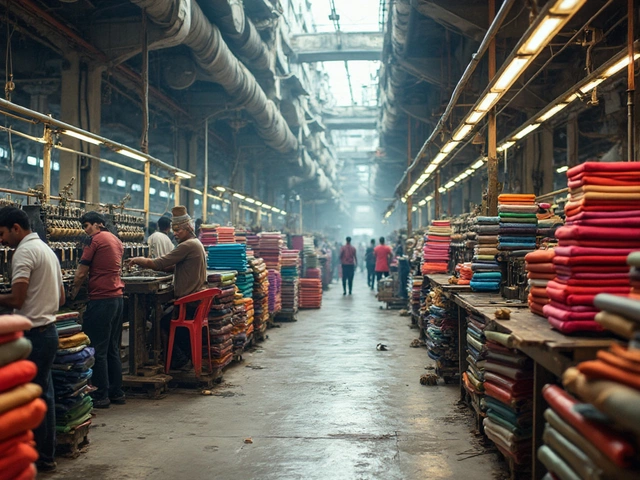Local Manufacturing Decision Checker
Local Manufacturing
- Reduced lead times
- Lower logistics costs
- Enhanced quality control
- Job creation
- Sustainability benefits
Offshore Manufacturing
- Lower labor costs
- Economies of scale
- Access to global talent
- Extended market reach
- Higher risk exposure
Answer the following questions to assess if local manufacturing suits your business:
Your results will appear here after answering the checklist questions.
When people talk about local manufacturing, they’re usually asking whether making products close to home actually matters. The short answer is yes-producing goods domestically reshapes costs, jobs, and the environment. Below you’ll find a clear definition, the upside and downside, real‑world examples, and a quick checklist to decide if a local supply chain fits your business.
What Exactly Is Local Manufacturing?
Local manufacturing is a production approach that keeps the entire or most of the value‑adding process within the same country or region as the end‑customer. It contrasts with offshore production where components travel across continents before reaching the market.
Key attributes of local manufacturing include:
- Geographic proximity between factory and consumer.
- Supply‑chain loops that stay within national borders.
- Often, a strategic focus on “Made‑in‑[Country]” branding.
Why Companies Choose Domestic Production
Going domestic isn’t just a feel‑good move; it can improve the bottom line and brand perception. Here are the most common drivers:
- Reduced lead times: Shipping across oceans adds weeks, while a local truck can deliver in days.
- Lower logistics costs: No long‑haul freight, fewer customs fees, and less inventory tied up in transit.
- Enhanced quality control: Proximity lets engineers spot defects faster and iterate on design.
- Job creation: Domestic factories generate skilled positions, boosting local economies.
- Sustainability: Shorter trips mean fewer carbon emissions, aligning with green‑brand promises.
Many firms also tap government incentives such as tax credits, grants, or low‑interest loans aimed at reshoring production to offset initial setup costs.

Common Challenges and How to Overcome Them
Local manufacturing isn’t a magic bullet. Below are the hurdles you’ll likely hit and proven ways to navigate them:
- Higher labor rates: In many developed economies wages exceed offshore levels. Mitigate by investing in automation and upskilling workers to increase productivity.
- Limited scale economies: Smaller plants can’t always match the volume discounts of massive overseas factories. Focus on niche or customized products where value outweighs cost.
- Supply‑chain gaps: Domestic suppliers for certain components may be scarce. Build strategic partnerships early and consider dual‑sourcing to ensure resilience.
- Regulatory compliance: Local factories must meet stricter safety and environmental standards. Leverage certification programs (ISO, UL) to turn compliance into a market advantage.
Successful reshoring stories often blend technology, government support, and a clear market positioning that justifies a premium price.
Local vs. Offshore Manufacturing: A Side‑by‑Side Look
| Attribute | Local Manufacturing | Offshore Manufacturing |
|---|---|---|
| Lead Time | Days to weeks (domestic transport) | Weeks to months (sea freight) |
| Transportation Cost | Low to moderate | High (fuel, freight, customs) |
| Carbon Emissions | Significantly lower | Higher due to long‑haul shipping |
| Quality Control | High - frequent site visits | Variable - depends on partner oversight |
| Job Creation | Directly adds local jobs | Creates jobs abroad, limited local impact |
| Risk Exposure | Lower geopolitical risk, but higher labor cost risk | Higher exposure to tariffs, political instability, exchange‑rate swings |
Real‑World Examples Across Industries
Seeing the concept in action helps cement its relevance. Here are four sectors where local manufacturing has taken hold:
- Automotive: A Midwest U.S. plant now assembles electric‑vehicle batteries for a major carmaker, cutting delivery time from 40days (China) to 5days.
- Apparel: A boutique fashion brand sources fabrics from a nearby textile mill in North Carolina, allowing on‑demand production and zero‑inventory models.
- Electronics: A European smartphone startup moved PCB assembly from Southeast Asia to a Polish facility, reducing carbon footprint by 30% and enabling rapid firmware updates.
- Food Processing: A regional snack company shifted chip frying to a local plant, ensuring fresher products and marketing the “Made‑in‑Texas” tag.
Each case highlights a blend of cost, speed, and branding benefits that outweigh the higher labor expense.

Checklist: Is Local Manufacturing Right for Your Business?
Before you jump into a reshoring project, run through this quick audit:
- Is your target market concentrated within a few hundred miles of a potential plant?
- Do you have a product that benefits from fast iteration or customization?
- Can you access a reliable domestic supplier network for critical components?
- Are there government programs or tax incentives that offset higher labor costs?
- Is your brand story stronger when you emphasize “Made‑in‑[Country]”?
If you answer “yes” to most questions, a local supply chain is worth a deeper feasibility study.
Future Outlook: The Rise of Hyper‑Local Production
Technology is nudging local manufacturing into new territories. 3‑D printing, modular factories, and AI‑driven demand forecasting let small firms produce on‑demand without massive upfront investment. As consumer demand for transparency and sustainability grows, the “local” label may become a baseline rather than a premium differentiator.
In short, local manufacturing is evolving from a niche strategy to a mainstream option for businesses that value speed, quality, and community impact.
Frequently Asked Questions
What defines a product as locally manufactured?
A product is considered locally manufactured when the majority of its value‑adding steps-such as material processing, assembly, and testing-occur within the same country or region where it will be sold.
How does local manufacturing affect product pricing?
While labor costs can be higher, savings from reduced shipping, lower inventory carrying costs, and fewer tariffs often offset the gap. Premium pricing can also be justified through a sustainability or “Made‑in‑local” narrative.
Are there specific incentives for reshoring in the United States?
Yes. Programs like the Tax Cuts and Jobs Act’s Bonus Depreciation, the Department of Commerce’s “SelectUSA” service, and state‑level tax abatements encourage companies to bring production back to the U.S.
Can small businesses benefit from local manufacturing?
Absolutely. Small firms can leverage flexible, modular factories and on‑demand production technologies to avoid large upfront capital while still enjoying faster market response and local brand appeal.
What risks should I watch out for when reshoring?
Key risks include higher labor costs, potential skill gaps, and limited supplier ecosystems for specialized components. Conduct a thorough cost‑benefit analysis and consider dual‑sourcing to mitigate these issues.









